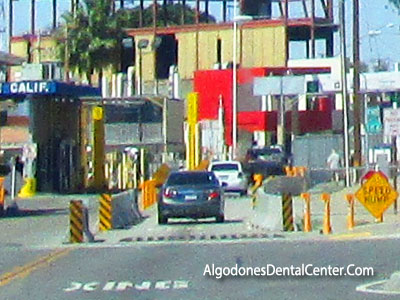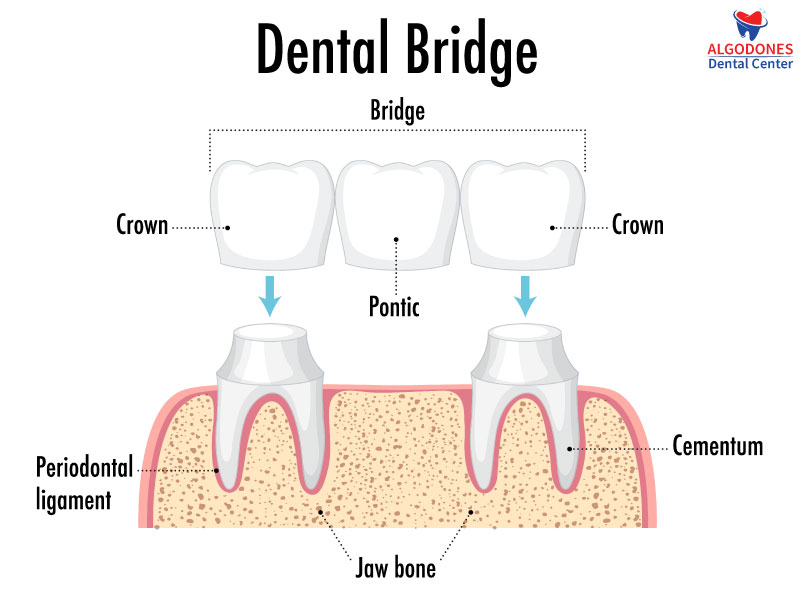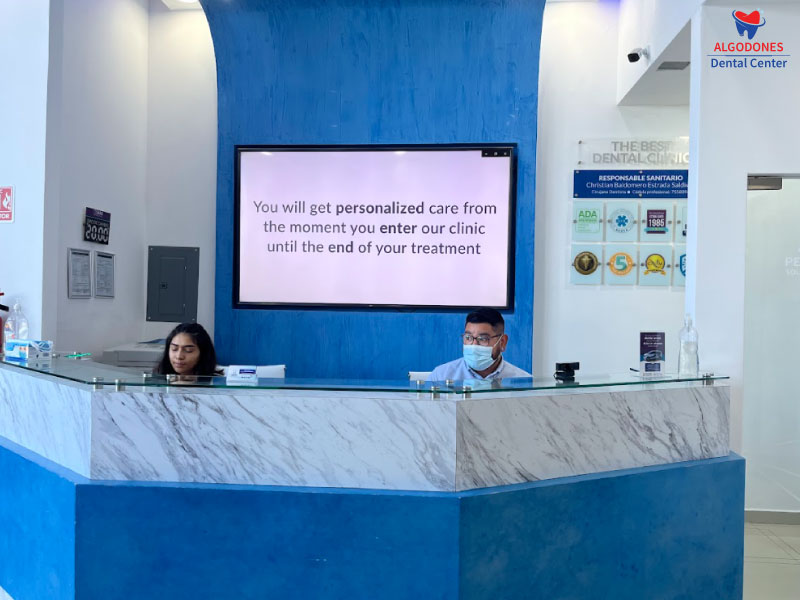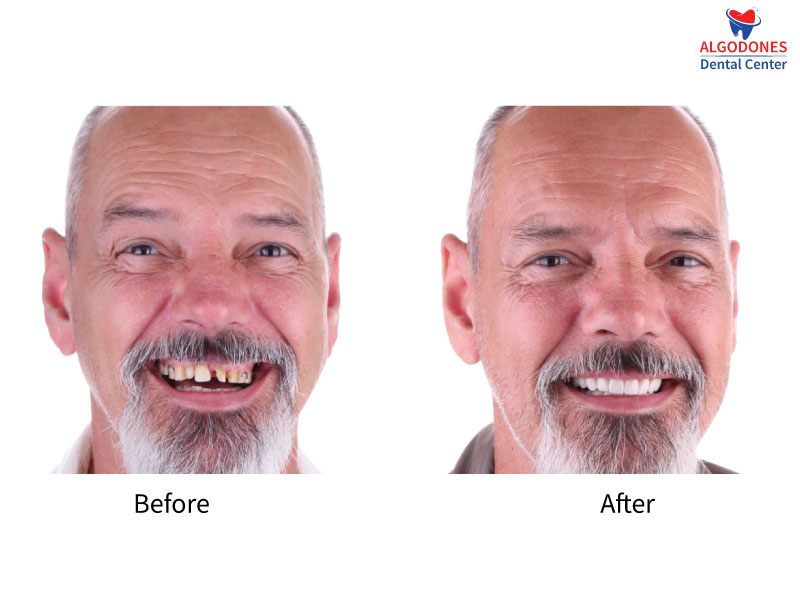Medically Reviewed by Dr. Hermes Somonte Davila, DDS, MS
Save upto 93% on dental bridges in Los Algodones at a state-of-the-art Mexican clinic with bilingual staff, plus a free 3-night stay for treatments over $2,000 USD. Read to know more now!
If you are missing multiple teeth, consider replacing them with implant supported dental bridges in Los Algodones, Mexico.
What is a dental bridge?
If you have missing teeth, your dentist can use dental bridges to fill the gaps.
A bridge is an artificial tooth (pontic) that is held in place by the teeth on each side of the gap.1
It consists of one or more artificial teeth, known as pontics, which are anchored in place by dental crowns or abutments on either side of the gap.
These crowns or abutments are placed on the natural teeth or dental implants adjacent to the empty space and serve as anchors for the bridge.2
What are the different types of dental bridges available in Los Algodones?
Let’s take a look at the types of dental bridges available in Los Algodones that can help your smile makeover:
Traditional Bridges
Traditional bridges are the most common type of bridge and involve creating a crown for the tooth or implant on either side of the missing tooth, with a pontic in between.3
They can be made of either porcelain fused to metal or ceramics.
Cantilever bridges
Cantilever bridges are very similar to traditional bridges, but the pontic is supported by an abutment on only one side rather than on both sides.4
Maryland bonded bridges/Resin-bonded Bridge
Maryland bonded bridges/Resin-bonded bridges are made of porcelain, porcelain-fused-to-metal, or plastic teeth and gums supported by a metal or porcelain framework.5
Implant-Supported Bridges
Instead of relying on crowns or frameworks for support, these bridges receive support from dental implants.6
Typically, in Los Algodones dental implants supported bridges, a single implant is strategically positioned for each absent tooth.
This sequence of implants serves as the foundation that secures the bridge in its position.
If inserting one implant for each lost tooth is not possible, the bridge may consist of a pontic hanging between two implant-supported crowns.
How much is a dental bridge in los algodones Mexico?
The average cost of dental bridges in Los Algodones Mexico is $1,030.
A porcelain fused to metal bridge costs $640 in Los Algodones Mexico, while the same costs $3,300 in the US.
This implies a saving of 81%!
Also, a zirconia bridge in Los Algodones Mexico costs $1,470, while the same costs $6,000 in the US, which saves you up to 77% on dental costs!
See the cost of dental work in Los Algodones Mexico below:
Dental Bridges in Los Algodones vs. the US Cost Comparison
| Procedure | Mexico (USD $) | US (USD $) | Savings (%) |
| Porcelain Fused to Metal Bridge* | $640 | $3,300 | 81% |
| All Metal Crown* | $1,800 | $7,500 | 76% |
| Porcelain Fused to Metal Crown | $690 | $1,500 | 54% |
| Full Porcelain or Ceramic Bridge* | $1,185 | $5,400 | 78% |
| Zirconia Bridge* | $1,470 | $6,000 | 77% |
| Temporary Bridge* | $90 | $1,350 | 93% |
| All Metal Bridge | $360 | $1,500 | 76% |
*prices are for a 3-unit bridge.
You can clearly see that you can save up to 93% on dental bridges in Los Algodones Mexico today!
Now, let’s explore some of the benefits of getting dental bridges in Los Algodones!
What are the benefits of getting dental bridges in Los Algodones?

What documents Are Required for Crossing The Border?
| Documents required to enter Mexico | Documents required to re-enter the USA |
| You must present a valid U.S. passport.7 | Children under the age of 15 who arrive in the US by land or water from Mexico can submit an original or copy of their U.S. birth certificate (issued by the Vital Records Department of the birth state).8 |
| An entry permit or Forma Migratoria Multiple (FMM) (when traveling 25 km further into Mexico from the border).9 | Travelers coming from Mexico to the United States must present a valid U.S. passport.10 |
| A valid passport book is required to enter Mexico by air, and those entering an airport with a U.S. passport card will be denied admission.11 | US citizens (including infants and minors) entering the country by land or sea must present a valid WHTI-compliant travel document.12 |
| Entering/Exiting Mexico – CANADA |
|---|
| In contrast to citizens of certain other nations, Canadian citizens enjoy visa-free entry into Mexico; however, they must fill out a Mexican tourist card, often referred to as an FMM (Forma Migratoria Múltiple).13 All Canadians entering Mexico either by plane or land should have a tourist card filled out and have it stamped at their first port of entry.
Forma Migratoria Multiple (FMM) (for travel beyond the border zone – about 25 km from the border crossing). |
| Canadian Travelers Visiting Mexico with Children Should Carry: |
| A valid passport for each child.
The child’s birth certificate
If a child is traveling alone or with a third-party of legal age, a letter of authorization signed by the other parent, or both parents, as the case may be. |
Why get Tooth Bridges at ADC?
We offer affordable packages for partial and full mouth restoration in Los Algodones with tooth bridges. Some of the highlights of our dental clinic in Los Algodones are:
Payment for Dental Bridges can be made through:
Benefits of Dental Bridges
Some benefits of quick and painless dental bridges in Los Algodones Mexico include:14,15
Studies suggest a success rate resin-bonded bridges of over 92.3%.16
Dental Bridges in Los Algodones Procedure
The dental bridge procedure in Los Algodones, Mexico, is a carefully structured process aimed at restoring the health and appearance of your teeth.
Read below for a step-by-step breakdown of the procedure:17
Desensitizing and Reshaping
Upon arriving at the dental clinic, your experienced dentist will first inject a local anesthetic into the gum tissue adjacent to the tooth next to the bridge.
The next crucial step involves reshaping the teeth that will serve as anchors for the dental bridge. This may entail filing down sections of the tooth or using dental fillings to create the ideal shape.
These adjustments are necessary to ensure a secure fit for the crowns that will support the bridge.
Fitting a Substitute
Once the teeth are appropriately reshaped, your dentist will take an impression of the missing tooth and the surrounding teeth.
While the permanent bridge is being made, you will receive a temporary bridge secured in place with cement to fill the gap.
The temporary bridge serves as an interim solution until the permanent one is ready, which typically takes a few weeks.
Placement of the Permanent Bridge
Once the permanent bridge is ready, you must return for a follow-up visit.
During this appointment, the dentist will carefully place the permanent bridge in your mouth.
What is the difference between a denture and a bridge?
| Denture | Bridge |
|---|---|
| Requires no tooth preparation at all.18 | The teeth are prepared by removing some enamel to make place for the crown. |
| It is removable. | A permanent dental bridge is not removable, can only be removed by a dentist. |
| Requires multiple visits for occlusion correction. | Only 2-3 visits are required as impressions are taken before and fitted to the implant surface. |
| Uses clasps for retention. | It does not use clasps for retention. |
| Derives its retention from clasps, abutment teeth, and the jaw bone. | A bridge relies on the abutment teeth for retention.19 |
Factors Affecting Success of Fixed Dental Prostheses (FDP)
The success of tooth bridges depends on many factors such as crown length and available bone.
If the crown length is poor, retention will be poor and in order to increase the retention crown lengthening may be required.
The success of a dental bridge depends upon:
Aftercare
It may take a few weeks for you to adjust to the new bite with the bridge. It may need some minor adjustments to settle down. Here are a few points to keep in mind:
Number of Appointments Required
Usually two-three appointments are required.22
A dental bridge with Algodones Dental Center, Mexico, will involve a consultation with the dentist to determine whether a bridge is a good option for you.
The dentist will take X-rays to determine tooth and bone health. For its successful placement it is important that your gums are in good health.
Modern-day dentistry aims to restore normal functions related to speech, aesthetics and oral health in the edentulous.
There are numerous harmful consequences of missing some or all of your teeth including:
Conclusion
Opting for dental bridges in Los Algodones, Mexico not only ensures remarkable savings of up to 93%.
But also presents the opportunity to combine dental care with a dream vacation, effortlessly checking off a bucket list item.
Los Algodones, Mexico offers a diverse array of attractions, from exquisite cuisine and tranquil beaches to an exhilarating nightlife scene.
Get a free quote today and allow us to guide you on the path to reclaiming your radiant smile.
FAQs
References
- Healthline-Dental Bridge
- Colgate- Dental Bridges
- Colgate- Four Types of Dental Bridges
- Ministry of Foreign Affairs- Know Before You Go
- US Custom & Border Protection- US Customs & Border Protection
- University of California San Francisco- Travel & U.S. Re-entry in H-1B
- U.S. Department of State- Mexico International Travel Information
- Tourist Card Mexico- Mexico Entry Requirements for Canadian Citizens
- Research Gate- Dental Bridge Procedure to Straighten Loose Teeth, A Review
- Web MD- Dental Health and Bridges
- BDJ- A review of the success and failure characteristics of resin-bonded bridges
- Colgate- Understanding A Dental Bridge Procedure
- BDJ- Rehabilitating a severely worn dentition with removable prosthodontics
- BDJ- Practical advice for successful clinical treatment with resin-bonded bridges
- NCBI- Home use of interdental cleaning devices, in addition to toothbrushing, for preventing and controlling periodontal diseases and dental caries
- Colgate- Mouthguards: Everything You Need To Know
- Medical News Today- Dental bridge: Everything you need to know







